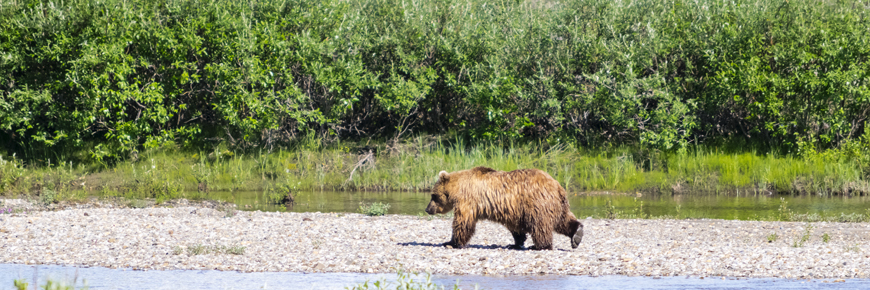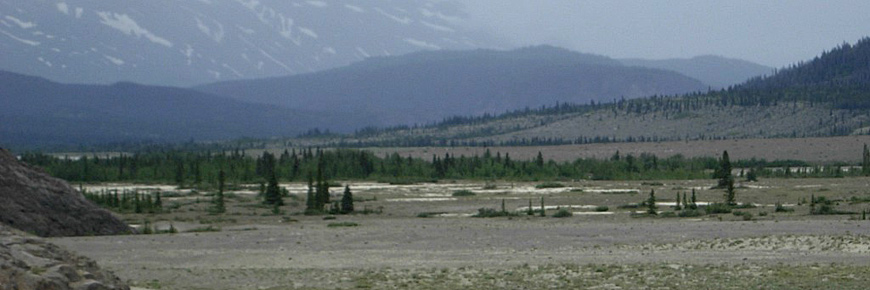
Bears in the Alsek River Valley
Kluane National Park and Reserve
As travellers on the Alsek River you will be sharing prime bear habitat with the grizzlies and black bears in the valley. Understanding bear behaviour and ecology, and managing your activities appropriately, will minimize the chance of displacing bears or experiencing negative bear-human interactions during your trip.
Your actions may ultimately affect whether healthy populations of bears are maintained in Kluane. This is a key management goal for the park. We hope you take your role in assisting us seriously. Read the information below and if you have any questions, do not hesitate to call us for more details before you arrive.
Why the Alsek River valley is important to bears
The Alsek River valley is home to both grizzly and black bears. The valley is well used by both species throughout their active period (April - October). Plants used by bears in the spring, summer and fall are abundant and widespread along the valley bottom where you will be travelling.
Peak bear use of the valley bottom, in the Special Preservation Area, occurs during the rafting season. Well-used game trails and an abundance of marked trees are evidence that the valley bottom serves as an important travel corridor for bears.
Bear ecology
Like humans, grizzly and black bears are omnivores. They feed on both plants and animals. Although bears on the Alsek River, opportunistically feed on animals such as moose or ground squirrels (and salmon on the lower Alsek), the major portion of their diet consists of specific plants that are abundant and relatively easy to obtain. Learn to identify these plants before you arrive in Kluane. Plant identification guides may be available at your local library or bookstore. You may want to talk to a local naturalist or botanist as well.
Feeding is a grizzly bear's primary activity from April through till October. Bears feed on plants at times of the year when the foliage is easier to digest and full of nutrients. Many leafy plants are eaten just as the leaves emerge. Roots are eaten in spring, late summer and fall (when most of the plant's nutrients are stored there).
Grizzly bear habitat selection is strongly related to the seasonal availability of specific plants. As a result, disturbance or displacement from important feeding habitats have serious impacts on a bear's ability to acquire the necessary nutritional reserves for reproduction and survival through its 5-7 month winter denning period.
Grizzly Bear Habitats and Foods

Wide open benches and gravel fans are common in the Special Preservation Area. These are popular feeding areas for bears. Bears feeding in these areas may be particularly vulnerable to disturbance by people. The open areas offer no cover or security to which they can escape. In open habitats, bears have been observed running for cover, sometimes for extensive distances. Bears that are wary of humans, particularly females with young of the year, are likely to be displaced from these habitats if disturbed.
All campsites are potential feeding areas or have potential feeding areas close by. When selecting a campsite, look for plants eaten by bears and become familiar with habitats where these plants are found. Camp in lower quality bear habitats that have a sparse abundance of bear foods! Select campsites that are open and sparsely vegetated to maximize the potential for you to detect bears and bears to detect you.
Upstream of Lowell Lake

Upstream of Lowell Lake bearroot, kinnikinnick, horsetail, field locoweed and soapberry are the main plants eaten by grizzly bears during the rafting season. These plants are abundant along the river.
Bearroot is common but found in localised areas and is particularly important to bears in years when the berry crops fail.
Horsetail is common on wet slopes with a white spruce over story and less common on the river edge.
Field locoweed is common and wide spread on open river flats that are likely to be chosen for campsites.
Soapberry and kinnikinnick are common and widely distributed along river flats, edges of treed areas and in open stands of white spruce. Soapberry is frequently present in or on the edges of potential campsites.
| Month | Plant | Plant Part Eaten |
|---|---|---|
| May | Bearroot ( Hedysarum alpinum ) Horsetail ( Equisetum spp.) Kinnikinnick ( Arctostaphylos uva-ursi ) |
roots leaves over-wintered berries |
| June | Horsetail Locoweed ( Oxytropis spp.) (primarily Oxytropis campestris ) |
leaves flowers |
| July | Locoweed Horsetail Soapberry ( Shepherdia canadensis ) |
flowers leaves berries |
| August / September | Soapberry Kinnikinnick Bearroot (most important when berries are less abundant) |
berries berries roots |
1 Less common food items include cow parsnip, grasses, sedges, willow catkins, rosehips, other berries, arctic ground squirrels, and ungulates such as moose.
Downstream of Lowell Lake
As you travel downstream of Lowell Lake there is a marked transition from drier interior vegetation to wetter coastal vegetation. The vegetation is typically more dense. While thick vegetation provides greater security for bears, these areas have an increased risk of surprise bear/human encounters. The terrain is also steeper in some areas leaving bears with fewer travel options along the river. Habitats along the river below Lowell Lake are also important to bears. However, their food habits here may be different. Several food plants are known to be important to bears.
| Plant | Plant Part Eaten |
|---|---|
| Bearroot ( Hedysarum alpinum ) | roots |
| Locoweed ( Oxytropis spp.) | leaves |
| Horsetail ( Equisetum spp.) | flowers |
| Kinnikinnick ( Arctostaphylos uva-ursi ) Red bearberry ( Arctostaphylos rubra ) Raspberry ( Rubus spp.) Blueberry ( Vaccinium spp.) Crowberry ( Empetrum nigrum ) Currant and Gooseberry (Ribes spp.) Highbush-cranberry ( Viburnum edule ) Soapberry ( Shepherdia canadensis ) Red-osier dogwood ( Cornus sericea ) |
berries (including over over-wintered berries of some species) |
| Devil's Club ( Oplopanax horridus ) | early leaf shoots, berries |
| Sweet-Cicely ( Osmorhiza spp.) | roots |
| Angelica ( Angelica spp.) | leaves, stems |
| Cowparsnip ( Heracleum lanatum ) | leaves, stems |
| Fireweed (Epilobium angustifolium) | early leaf shoots |
1 Other food items may include arctic ground squirrels, moose, salmon, grasses, sedges, willow catkins, rosehips ( Rosa spp.), twisted stalk ( Streptopus spp.) and other berries.
Lava North Portage UTM - 7V 666650/ 6670100
The Lava North Portage is a high-risk area for surprise encounters. Bear sign such as tracks, scats and diggings are common in this area. Be aware that visibility is poor, noise from the river can be loud and the wind is frequently blowing upstream. All of these factors greatly reduce a bear's ability to avoid you.
When walking through this area, stay in as large a group as possible and make loud noises. Be aware that other high-risk areas are common along the river. Learn to recognize and avoid these areas.
Bear safety
In addition to the information provided here, be sure to read the You Are In Bear Country brochure provided and other books on bear ecology and biology. You may want to check with your local university for the latest literature recommendations.
Reporting bear incidents and observations
All river users are required to report bear incidents to either Kluane National Park or Glacier Bay National Park. If you are involved in an incident or an encounter with a bear please record and report the information as soon as possible.
At the end of your trip please return your completed bear report forms to the Dry Bay Ranger, Glacier Bay National Park, or Kluane National Park. This will enable Resource Conservation staff to track changes in bear behaviour and monitor bear use of designated campsites. The information is used to identify potential problems, which may then be investigated and appropriate management action taken.
To report bear-human conflicts

Kluane National Park and Reserve
Phone number: 1-877-852-3100 (toll free)
Mail bear observation forms to:
Kluane National Park and Reserve
P.O. Box 5495
Haines Junction, YT, Y0B 1L0
Glacier Bay National Park & Tatshenshini-Alsek Park
Phone number:
1-907-697-2627 7 am to 9 pm, leave a message.
Phone number:
1-907-697- 2651 24 hr Emergency
Mail bear reports to:
Attn: Biological Science Technican
P.O. Box 140
Gustavus, AK, 99826
- Date modified :